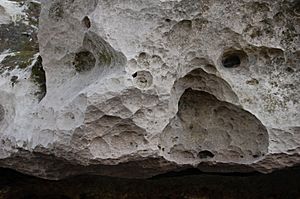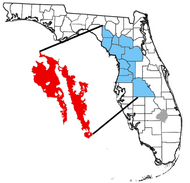Ocala Limestone facts for kids
Quick facts for kids Ocala LimestoneStratigraphic range: Eocene |
|
|---|---|
 |
|
| Type | Geological formation |
| Underlies | Suwannee Limestone (Oligocene) |
| Overlies | Avon Park Formation |
| Thickness | Lafayette-Sumter counties |
| Lithology | |
| Primary | limestone and dolomite |
| Location | |
| Region | North Florida |
| Country | |
| Type section | |
| Named for | Ocala, Florida (city) |
The Ocala Limestone is a special type of rock found in Florida, USA. It's a geologic formation, which means it's a distinct layer of rock that geologists study. This rock formed during the late Eocene Epoch, many millions of years ago. You can find it near the city of Ocala in Marion County, Florida.
Contents
How Old Is the Ocala Limestone?
The Ocala Limestone formed during the Paleogene Period. More specifically, it was created during the late Eocene Epoch. This was a long time ago, roughly between 55.8 and 33.9 million years ago. Imagine how much the Earth has changed since then!
Where Can You Find It?
The Ocala Limestone is found close to the surface in parts of Florida. It's a big part of the Ocala Karst District in west-central and northwestern Florida. You can also find it in the Dougherty Plain District in the northern panhandle.
This rock layer easily forms karst features. Karst is a type of landscape where limestone bedrock has been dissolved by water. This creates cool features like sinkholes, caves, and underground rivers. In these areas, you might see streams that disappear underground or many natural springs.
What Is It Made Of?
The Ocala Limestone is mostly made of very pure limestone. Sometimes, it also contains dolomite, which is another type of rock similar to limestone.
Scientists can divide the Ocala Limestone into two main parts: a lower part and an upper part.
- The lower part is usually whitish or cream-colored. It's made of fine to medium-sized grains and is full of fossils.
- The upper part is white and not as strong. It's also packed with fossils and sometimes has chert, which is a hard, glassy rock.
Because the Ocala Limestone is very permeable, meaning water can easily flow through it, it's a super important part of the Floridan Aquifer. This aquifer is a huge underground water source that provides drinking water for many people in Florida.
What Is Above and Below It?
The Ocala Limestone sits on top of another rock layer called the Avon Park Formation. Think of it like a sandwich: the Avon Park Formation is the bottom slice of bread, and the Ocala Limestone is the filling. Together, these layers are part of a system that helps control how water moves underground.
What Fossils Are Found Here?
The Ocala Limestone is famous for its many fossils! Because it formed in ancient seas, you can find the remains of many sea creatures. Some common fossils include:
- Foraminifers: These are tiny, single-celled organisms with shells. One common type found here is Lepidocyclina.
- Echinoids: These are like ancient sea urchins and sand dollars.
- Bryozoans: These are tiny colonial animals that often look like moss or coral.
- Mollusks: This group includes ancient snails, clams, and other shelled creatures.
- Sometimes, very rare vertebrate fossils (animals with backbones) are also found.


